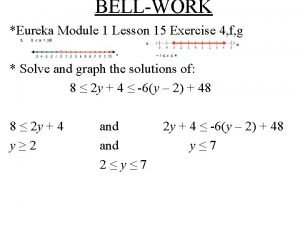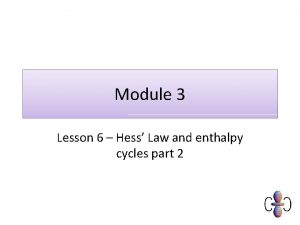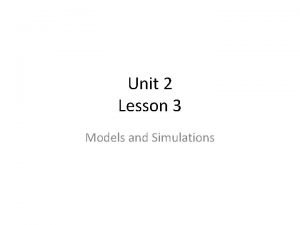MVP Module 7 Lesson 1 MVP NC Math






























- Slides: 30

MVP Module 7 Lesson 1 MVP NC Math 2 2019 -20

READY? Topic: Recalling Direct Variation Functions Pre. K-12 Mathematics

Pre. K-12 Mathematics

Identify whether the given equation represents a direct variation. If it does, state the constant of variation. If not, explain why. YES/NO Why? k? y – 7 x = 0 -2 x + 5 y = 0 5 x + y = 10 17 y = -34 x Pre. K-12 Mathematics

State whether or not each table represents a direct variation relationship. If it does, write the equation in y = kx form. Pre. K-12 Mathematics

State whether or not each table represents a direct variation relationship. If it does, write the equation in y = kx form. Pre. K-12 Mathematics

Which graph shows a direct variation relationship? Identify the features of a direct variation graph. Pre. K-12 Mathematics

Lesson Essential Question Pre. K-12 Mathematics

Lesson 7: Growing Roots A Develop Understanding Task Pre. K-12 Mathematics

In your previous math work with the Pythagorean Theorem you have learned about square roots as a number. In this task we will consider the square root function. We will begin by examining the context that gave rise to the name of this function, the relationship between the area and side length of a square.

Determine the area and side length of each of the following squares, and label both quantities on the diagram. Illustrate or explain how you found the measure of each quantity.

You may recall the following definition of square root: The square root of a number, N, is the factor, n, such that when a number is multiplied by itself, n x n, the product is N.




The diagram below was created using the following recursive process:

Determine the length of each line segment in this sequence, measured from the origin to the endpoint labeled in the diagram:

Let f(n) be the numerical length of the nth line segment in this sequence. Define f(n) recursively: f(1) = 1, and f(n) = Define f(n) explicitly: f(n) =

Use a compass to draw circles on the diagram, centered at the origin with radii of 1, 2, 3, and 4 units. What is significant about the endpoints in the diagram that lie on these circles? If we were to continue to construct line segments using this recursive patter, how many endpoints would lie between the circle of radius 4 and the circle of radius 5? What observations can you make about the number of endpoints that lie between consecutive circles?

The domain of this discrete sequence is the natural numbers. To graph this sequence, we could use the lengths of the line segments in the diagram to determine the value of the sequence for each natural number, as shown in the graph below.

SET? Topic: Identifying features of the square root function

Explain the reason for selecting 0, 1, 4, 9 and 16 for the x-values?

Circle all of the features that apply to the graph of the square root function. If you identify a feature, write the specific value(s) that describe the feature, if possible.

Circle all of the functions that represent a square root function.

GO! Topic: Graphing quadratic functions with transformations

Describe the transformation on each parabola. Then graph the function.

Describe the transformation on each parabola. Then graph the function.

Describe the transformation on each parabola. Then graph the function.

Describe the transformation on each parabola. Then graph the function.

EXIT TICKET Illustrate and annotate the key features of a square root function graph.
 Mvp math 1
Mvp math 1 Mvp math 2
Mvp math 2 Grade 6 module
Grade 6 module Eureka math grade 6 module 1 lesson 1
Eureka math grade 6 module 1 lesson 1 Eureka math algebra 1 module 1 lesson 15
Eureka math algebra 1 module 1 lesson 15 C device module module 1
C device module module 1 Dropbox mvp
Dropbox mvp Mvp minimum viable product
Mvp minimum viable product Microsoft mvp certification
Microsoft mvp certification Azure vm ssd
Azure vm ssd Bcgsoft 사용법
Bcgsoft 사용법 Mvp surface sampling device
Mvp surface sampling device Mvp
Mvp Minimum viable product presentation
Minimum viable product presentation Concierge mvp
Concierge mvp Mvp corect ltd
Mvp corect ltd Mvp azure
Mvp azure Pilot mvp
Pilot mvp 00102 introduction to construction math
00102 introduction to construction math Business math proportion
Business math proportion Eureka math algebra 1 module 4
Eureka math algebra 1 module 4 Eureka math 3rd grade module 7
Eureka math 3rd grade module 7 Math game math hit the button
Math game math hit the button Module 9 lesson 2
Module 9 lesson 2 Module 5 lesson 5
Module 5 lesson 5 Practical/logistical issues in relationships
Practical/logistical issues in relationships Module eleven lesson one self check quiz
Module eleven lesson one self check quiz Grade 5 module 1 lesson 1
Grade 5 module 1 lesson 1 Segment relationships in circles lesson 15-4
Segment relationships in circles lesson 15-4 Module 3 lesson 6
Module 3 lesson 6 Math models unit 3 lesson 3
Math models unit 3 lesson 3




















































